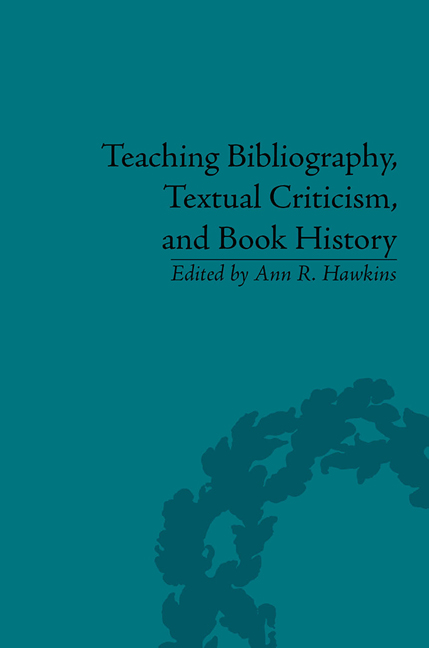Book contents
- Frontmatter
- Contents
- Notes on Contributors
- Foreword
- Introduction: Towards a pedagogy of Bibliography
- Part I Rationales
- Part II Creating and Using Resources
- Book History on the Road: Finding and Organizing Resources Outside the Classroom
- Jane Eyre on eBay: Building a Teaching Collection
- History of the Book in the American Literature Classroom: On the Fly and on the Cheap
- From Printing Type to BlackboardTM: Teaching the History of the Early Modern Book to Literary Undergraduates in a ‘New’ UK University
- Part III Methodologies
- Teaching ‘History of the Book’
- Teaching Bibliography and Research Methods
- Teaching Textual Criticism
- Part V Resources
- Index
Jane Eyre on eBay: Building a Teaching Collection
from Part II - Creating and Using Resources
- Frontmatter
- Contents
- Notes on Contributors
- Foreword
- Introduction: Towards a pedagogy of Bibliography
- Part I Rationales
- Part II Creating and Using Resources
- Book History on the Road: Finding and Organizing Resources Outside the Classroom
- Jane Eyre on eBay: Building a Teaching Collection
- History of the Book in the American Literature Classroom: On the Fly and on the Cheap
- From Printing Type to BlackboardTM: Teaching the History of the Early Modern Book to Literary Undergraduates in a ‘New’ UK University
- Part III Methodologies
- Teaching ‘History of the Book’
- Teaching Bibliography and Research Methods
- Teaching Textual Criticism
- Part V Resources
- Index
Summary
Book history presupposes that the physical artifacts in which texts appear fundamentally shape the experience, reception, and meaning of those texts. A book history approach, then, engages students with texts-as-artifacts. In teaching a novel, that engagement might take two shapes: first, an encounter with contextualizing materials that illuminate the content of the novel; and second, an examination of materials that reveal what happens when a novel becomes a cultural icon. With modern editions of Jane Eyre, for example, students will not realize that the novel's original form – as a three-decker – influenced the way the work took shape. If apprised of this original structure, students can trace the cliff-hanger-like endings of the first two volumes, contemplate how this structure affected Charlotte Brontë's compositional strategies, and imagine what the experience of reading the novel was like for members of subscription libraries as they checked out one volume at a time. Nothing can replace the experience of seeing a three-decker novel, or of examining at first hand the kinds of contextualizing materials that can help bring a novel like Jane Eyre to life, such as a marriage license on parchment, examples of the sort of ‘Hindustanee’ glossaries St John rivers gives Jane Eyre to study, or illustrations from books Jane Eyre describes, such as the potent wood engravings in Bewick's British Birds.
- Type
- Chapter
- Information
- Publisher: Pickering & ChattoFirst published in: 2014

